Spanish Sunday
Sunday, April 23, 2023
 I love Sundays. Although I’m long retired and pretty much every day is the same, more or less, I still find Sunday a special day. Not that I always did, mind you. I wrote about hating Sundays in a previous article, Sunday, Bloody Sunday. I love Sundays. Although I’m long retired and pretty much every day is the same, more or less, I still find Sunday a special day. Not that I always did, mind you. I wrote about hating Sundays in a previous article, Sunday, Bloody Sunday.
When I rise on the Seventh Day, I brew a cup of PG Tips, Yorkshire Tea or English Breakfast and take a peek at the Spanish News on La1. I find the Spanish equivalent of the BBC gives thorough coverage of world events and is not all parochial like the BBC or CNN tend to be. And it does my Spanish a power of good.
Next a second cuppa and a session on the computer to update my website, www.help-me-ronda.com. As a bare minimum I bring the WHAT’S ON – ENTERTAINMENT GUIDE up to date and add a new QUOTE OF THE DAY. I may also write or post an article to the BLOG or add some photos to the GALLERY.
After that I watch the repeat of MATCH OF THE DAY, before heading off to Ronda to get my Sunday papers: Spanish SUR, RONDA Semanal and the English freebies, SUR in English and The OLIVE PRESS.
 My Sunday ritual continues as I go for a breakfast treat – churros. This allows me to read the papers in peace. My Sunday ritual continues as I go for a breakfast treat – churros. This allows me to read the papers in peace.
SUR is an important paper for me, since it enables me to catch up on the latest international, national and regional news, improving my Spanish all the while.
RONDA Semanal gives me the local news. I learn some new vocabulary or expression nearly every time.
SUR in English is a digest of the past week’s news plus some original columns by English journalists.
The OLIVE PRESS, published fortnightly is good for its coverage of environmental issues, fraud and corruption and its area-based or theme-based supplements.
Well-fed and well-read I sometimes go off to the market and or the garden centre.
By now it’s late morning, so I return home to do some gardening or maintenance on the house.
Both garden and house are large so there’s always loads to do. My vegetables and plants always need attention and weeds grow well and fast in the Andalusian climate.
Come the evening it’s time for a trip to the dump with our recycled rubbish and to my local for a pre-prandial beer or three.
Dinner prepared by my super-cook wife, the Lovely Rita, and MOTD2 completes a perfect day.
So, no more Sunday, Bloody Sunday, but Happy Sundays.
Sunday, Bloody Sunday (eyeonspain.com)
 2
Like
Published at 7:57 AM Comments (0)
2
Like
Published at 7:57 AM Comments (0)
Montejaque – an example of the internationalisation of Andalucía
Wednesday, April 12, 2023
Many towns and villages in Andalucía have a significant foreign population. Attracted by the climate, relaxed lifestyle, and lower cost-of-living, over the course of three or four decades, thousands of people from other countries have either emigrated or bought holiday homes here in southern Spain.
 Places like Mijas, Fuengirola, Benalmádena, Marbella, Torremolinos, San Pedro de Alcántara, Estepona, Nerja and Frigiliana all have sizeable numbers of 'guiris' among their residents. The incomers have integrated to varying degrees. Some have become elected councillors in their municipalities, others run thriving businesses, many are retired. Some simply seek sun, sangria and s*x and make no attempt to integrate, happy with their English beer and breakfasts, their German beer and Wurst. Places like Mijas, Fuengirola, Benalmádena, Marbella, Torremolinos, San Pedro de Alcántara, Estepona, Nerja and Frigiliana all have sizeable numbers of 'guiris' among their residents. The incomers have integrated to varying degrees. Some have become elected councillors in their municipalities, others run thriving businesses, many are retired. Some simply seek sun, sangria and s*x and make no attempt to integrate, happy with their English beer and breakfasts, their German beer and Wurst.
Montejaque
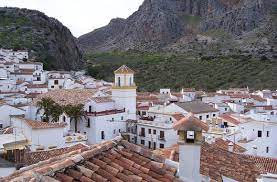 Montejaque, a small pueblo blanco in the Ronda mountains of inland Málaga province, is a case in point, although only four per cent of the registered population is foreign. Montejaque, a small pueblo blanco in the Ronda mountains of inland Málaga province, is a case in point, although only four per cent of the registered population is foreign.
Montejaque has a registered population of less than 1000. Of those approximately 40 are foreigners. Another 40 or so are property-owners in the village but live in other countries.
Astonishingly, for such a small place, the range of nationalities represented is very wide, from Asia to Zimbabwe, from the European Union to North America, from Eastern Europe to New Zealand.
Added to that, many Spanish who live and work elsewhere, eg in Málaga, Marbella, San Pedro and Sevilla, have holiday or inherited family homes here.
The housing market
The property market is buoyant again post-economic crisis and post-pandemic, with between 40 and 50 properties having been bought and sold in the village in 2022 alone!
There are two estate agencies with offices located in Montejaque and several others, including one independent, who are active in the area.
Mayor Diego Sán chez is delighted: “For several decades the village has benefited hugely from the investment in old properties here by the British, German, Dutch and other northern Europeans. In the last couple of years, immigrants hail from further afield, eg North America and the Antipodes.” chez is delighted: “For several decades the village has benefited hugely from the investment in old properties here by the British, German, Dutch and other northern Europeans. In the last couple of years, immigrants hail from further afield, eg North America and the Antipodes.”
Mayor Sánchez is also pleased at the level of integration and participation in village activities. “Our foreign community contributes hugely to the life of the village, taking part in fiestas, contributing to the local economy and making constructive suggestions for improvements. Some of the men also 'carry the Virgin' during religious processions.”
The foreign community
Montejaque has become quite cosmopolitan in nature. To this writers’ knowledge the following nationalities are represented in the village: American, Canadian, Dutch, English, French, German, Gibraltarian, Hungarian, Irish, Italian, New Zealanders, Polish, Scottish, South African, Zimbabwean.
There are two American couples who have recently moved to Montejaque on a permanent basis. Apparently, our American cousins no longer want to live in a post-Trump USA. A third couple, Paul and Dana from Texas, have a house here which is an official vivienda rural (holiday rental) until they eventually retire here.
 Much-travelled Carolyn and Kevin are English but hold Canadian passports from the time they lived there. Their children and grandchildren still live in Canada. Carolyn and Kevin moved here to live in 2012, when Kevin retired from his job in South Africa. Much-travelled Carolyn and Kevin are English but hold Canadian passports from the time they lived there. Their children and grandchildren still live in Canada. Carolyn and Kevin moved here to live in 2012, when Kevin retired from his job in South Africa.
Canadian Caroline L has lived in Spain, France, Italy and Spain again, for the last year or so in Montejaque. An engineer, she can work remotely. A born linguist, she speaks English (with a Canadian accent), Spanish, French and Italian.
Two Dutch couples bought property in the village in 2022 and a Dutch teacher, Erwin, in 2021. None live here permanently, although Anja and Ronald intend to move here permanently in a couple of years. Both can work from Spain; Anja intends to start a catering business and Ronald will continue to work as a truck driver. Iwo and Katja are still relatively young and have their careers elsewhere, but they are often to be seen in the village.
The English are probably the most-represented nationality in Montejaque. The residents hail from places as far afield as Birmingham, Brighton, Cheshire, Devon, Essex, Greater Manchester, Hastings, Liverpool, Portishead (Bristol) and Yorkshire. Most are retired but some dabble in property development, house sales, offer “fixing” and translation services or are engaged in tourism activities.
Jill, from Manchester, moved to Spain over 20 years ago. With husband Bill, they bought an ecological farm in Yunquera but decided to live in Montejaque. Sadly Bill died suddenly in 2009, but Jill continued to run the farm for several years. She has since sold it and recently has got together with long-time friend, retired English bobby John, a Scotsman with a house in Montejaque who has finally, despite some difficulties as a result of Brexit, become a resident.
Tony and Lynne from Hastings moved here just before the pandemic. They have two houses. They live in one and rent the other.
Steve and Rosie, from Lymm in Cheshire, had a holiday home here and got trapped here by the pandemic lockdown. They enjoyed life in Montejaque during those two years that they are now virtually full-time residents.
Mike and Chris sold their thriving restaurant and pub portfolio in Portishead and moved to Montejaque in 2022. They are early retirees who enjoy an active life hiking, running, skiing and so on. Mike is not so active at the moment, however, as he broke his shoulder whilst snowboarding in France earlier in 2023.
Steve and Margaret retired here some five years ago. They sold their original house in the village recently and bought another, higher up in the old part.
Andrew and Tracy are still young enough to have to work. They have rental properties in Ronda and Gaucín but live in Montejaque.
Early retirees Jane and Colin bought a lovely villa with pool and almond orchard at the entrance to the village. They have now clocked up seven or eight years as residents.
Other English residents are Fiona and Ray from Cheshire and June and her husband Ian from Derby.
Paul has been resident since 2008. He fell in love with a local German lady, emigrated soon afterwards, married his “girl” and the rest is history. Paul, a graduate in Spanish and former teacher and school inspector, offers a variety of services including translation, “fixing”, home-finding and holiday accommodation. He also operates two websites: www.help-me-ronda.com and www.a1-holidays.net.
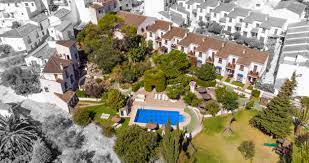 There are a couple of French property owners. Brigitte and husband Pedro own Casitas de la Sierra, a luxury “holiday resort” of nine houses round a swimming pool with private gardens. I haven’t met the other French folk yet. There are a couple of French property owners. Brigitte and husband Pedro own Casitas de la Sierra, a luxury “holiday resort” of nine houses round a swimming pool with private gardens. I haven’t met the other French folk yet.
The foreigner who has clocked up most years in Montejaque is octogenarian German, Elke. A pioneer property developer, back when Montejaque was in danger of dying, she bought, did up and and sold dozens of dilapidated properties in the upper Moorish part of the village. She retains a portfolio of rental properties in this part of the village.
There are other Germans too. For example, Rita, a retired intensive care nurse, came to Montejaque as a tourist 20 years ago from twin town Knittlingen, where hundreds of montejaqueños had gone to work in the 60s and 70s. She fell in love with the village and bought an old house on the second day of her visit! She had it “reformed” and she moved in two years later. She still has the house, Casa Rita, which is now a luxury holiday rental, although she now lives in Ronda with her husband of 12 years, the afore-mentioned Paul.
Isolde, another German immigrant, has lived in Spain for many years, at first on the coast in San Pedro de Alcántara and latterly in Montejaque.
Gibraltarian David and his English wife Sue alternate between the village and their home on the Rock.
There are two Hungarians, mother and daughter Judit and Krisztina from Budapest. They are currently renting an apartment in the village. Both teach English to Spanish adults and children and Judit organises lifestyle retreats.
The Irish have had a long tradition in the village. Longest serving is Pauline, married to a Spanish local for many years. Some Irish folk have moved back to Ireland because of old age and health issues. Another, Freida, moved away to Mallorca for several years but is now back in the area and living in Ronda. She is a trained TEFL teacher. Aisling and English partner Rick bought a house here in 2022, which they are currently doing up.
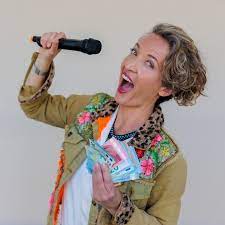 Two young Italians bought a house in the village last year. Manuela, a former CNN journalist, now a lifestyle coach, and husband Biagio, a chef, lived previously in Alicante but sought a quieter life in Andalucía, first of all in Tarifa (Cádiz) and then in Montejaque. Both are fluent Spanish speakers. Two young Italians bought a house in the village last year. Manuela, a former CNN journalist, now a lifestyle coach, and husband Biagio, a chef, lived previously in Alicante but sought a quieter life in Andalucía, first of all in Tarifa (Cádiz) and then in Montejaque. Both are fluent Spanish speakers.
Michael left South Africa aged 18 because he couldn't stand apartheid. After spells in the UK and the USA, he finally settled in Spain, where he has lived for over 30 years. Before moving to the mountains he lived in Estepona and Benahavis, where he was a successful entrepreneur. After a spell living on his finca in Benaojan, Michael is now settled in Montejaque. A fluent Spanish speaker he does a bit of house- and pet-sitting, although he's officially retired (he's nearly as old as I am!).
Scotsman George is married to Zimbabwean Jill. They have lived in Montejaque for donkey’s years and enjoy the quiet, relaxed Andalucía lifestyle.
Non-resident foreigners
New Zealander Richard bought a house in Montejaque in 2022, with a view to moving here eventually. I haven’t met Richard yet, but we are firm Facebook friends and keep in touch regularly. From his photos on Facebook, he clearly likes a drink, so he should fit in very well!
My next-door neighbours are Polish. Robert and Edita bought the house at the beginning of 2022 and plan to move here eventually. They apparently have Polish friends who are also keen to invest in the village. Watch this space.
Other non-residents who own property in Montejaque include Brenda and Jeremy (both retired); Patricia (painter) and Ian (retired) from Derbyhshire; Erika (translator) and Michael (university professor), Kristel (writer) and Heino (artist), and Jason (antiquarian bookseller) and Anne (teacher) all from Berlin; Melanie (travel agent), Angie (record producer), Maxine and Richard (both retired) from England; Sandra (retired) from Wales; and Jutta (German artist).
Caroline H (photographer) and Will have two houses in the village. Casa de la Roca is available to rent, Casa Rincón is for sale at a great price (contact A1 Holidays and A1 Inmobiliaria respectively - details below).
Integration
Many of the guiris are active in the life of the village. Carolyn, mentioned earlier, jointly compiled a bi-lingual recipe book with local Spanish friend Victoria, and Carolyn and Kevin both participate eagerly in local fiestas.
Steve, from Northern England, and Mike, from “dahn sarf”, help to carry the Virgin on parades on religious days, eg Easter. Steve is also an occasional DJ at the Hotel Palacete de Mañara. These discos are popular with the foreigners and locals.
 There are several artists, two from Scotland, one from Yorkshire and a couple from Germany, all of whom just love the bright natural light of Andalucía. Helen, a Scottish sculptress, donated the metal goat which has pride of place in front of the Town Hall. Another Scot, who wishes to remain anonymous, is a property developer, who incorporates her artistic designs into the furniture and décor of her houses. There are several artists, two from Scotland, one from Yorkshire and a couple from Germany, all of whom just love the bright natural light of Andalucía. Helen, a Scottish sculptress, donated the metal goat which has pride of place in front of the Town Hall. Another Scot, who wishes to remain anonymous, is a property developer, who incorporates her artistic designs into the furniture and décor of her houses.
A few others contribute to tourism in Montejaque by running holiday rental homes.
Others keep themselves to themselves and are enjoying their retirement.
Of the 40 permanent residents, perhaps half a dozen are fluent Spanish speakers. A good number of the others attend weekly classes in Spanish offered free-of-charge by the local council. The rest get by, one way or another.
***
So, Montejaque, cosmopolitan and international, yet small and beautiful and wonderfully traditional. If you haven’t visited, please do!
Further reading:
What is a guiri? It's what the Spanish call us foreigners - but is it good or bad? (secretserrania.com)
Contacts
Holiday accommodation:
Casa Montejaque - Paul on (+34) 636 52 75 16 (English, French, German, Spanish)
Casa La Paloma –Kathryn on (+44) 7769 885996 (English, French, German, Spanish)
Casa Pinzón - Kathryn on (+44) 7769 885996 (English, French, German, Spanish)
Casa Rita - Paul on (+34) 636 52 75 16 (English, French, German, Spanish)
Casa de la Roca - (+34) 636 52 75 16 (English, French, German, Spanish)
Casitas de la Sierra – Pedro on (+34) 670 81 07 40 (English, French, Spanish)
Websites:
www.a1-holidays.net
www.andaluciainlandproperties.com
www.casitasdelasierra.com
www.help-me-ronda.com
www.montejaque.es
 2
Like
Published at 11:16 AM Comments (2)
2
Like
Published at 11:16 AM Comments (2)
My Special Places in Spain
Friday, April 7, 2023
Pablo de Ronda first went to Spain in 1970, aged 20. Now, 53 years later, he has been living in Spain, in Andalucia, for the last 15 years. In the intervening years he has visited most parts of the country; every region, in fact, except Galicia. Along the way, many of these places have had a particular significance for this avid hispanist. Here are his reminiscences.
Barcelona to the Basque Country
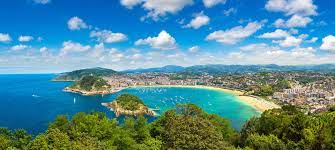 I first came to Spain when, together with six other Spanish language students, I flew to Barcelona at the start of our ‘year abroad’ which was a compulsory part of our languages degree. This was in 1970. I first came to Spain when, together with six other Spanish language students, I flew to Barcelona at the start of our ‘year abroad’ which was a compulsory part of our languages degree. This was in 1970.
We were going to San Sebastian (Basque country), and back then the easiest way was a flight to the Catalan capital and then by train across northern Spain to our final destination.
Well, we hadn’t taken account of the fact that it was Easter. When we tried to buy train tickets, all trains were fully booked! An alien concept for those of us used to half-empty British Rail trains. What to do?
Finally, we decided to hire a car – a big car, there were seven of us, three of us strapping lads. We got a large SEAT sedan based on the old Morris Oxford. Incredibly, I was the only one with a driving licence.
Many hours later – no motorways in Spain then – we arrived late at night in the Guipuzcoa capital to the sounds of Santana on the juke boxes and wine at two pesetas. We found accommodation in a fonda in the port and woke the following day to bright sunshine, the roar of the waves and a massive hangover.
The following day we went hunting for long-term digs and enrolled at the university, where we were to do a course for three months.
I loved San Sebastian. An elegant and classy Victorian resort, it was way different from anything I’d experienced before.
We did the course and we did the Parte Vieja – every night. Wow, what a place. The pintxos (tapas) were to die for and the drinks so cheap. I mentioned the wine, but beer was also cheap, just eight pesetas for a caña.
By the time the course was over, I had found myself a job in the office of a local tour operator. I was soon promoted to guide, which entailed collecting British and Irish catholic pilgrims from Lourdes in France and bringing them by coach to SanSe for a knees-up after all those "Hail Marys" in the French pilgrim site. We sold them excursions and showed them the highlights of the area.
I was so successful (apparently) tha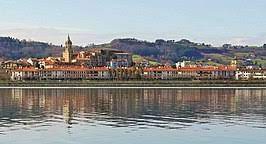 t I was invited back for the summer season for the next several years. t I was invited back for the summer season for the next several years.
San Sebastian is therefore on my list of special places in Spain, as is nearby Fuenterrabia (now Hondarribia) where a lot of my tourist work was focused. Many years later, aged 48, I was to return there with a girlfriend and we stayed in the Parador hotel, surely one of the best historic paradors in the whole of Spain.
Photos courtesy of spain.info and Wikipedia
El Prat de Llobregat
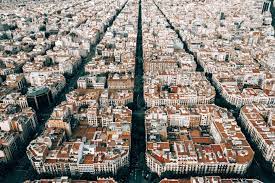 The town near Barcelona which is the home of the city’s airport. So, I had been there on that first trip to Spain back in 1970. The town near Barcelona which is the home of the city’s airport. So, I had been there on that first trip to Spain back in 1970.
This rather shabby and socially deprived town took on a greater significance for me after I organised a successful work experience programme for sixth-formers from schools in St Helens, Merseyside, where I worked for the education department, and for older pupils from schools in El Prat.
In the first year of the programme, 1995, I spent a week there monitoring the students, the placements and the menus del dia. Thoroughly worthwhile and enjoyable.
Photo courtesy of El Catalan
Jaca
 I attended a Spanish refresher course in Jaca (Aragon) in July 1998. Run by the European Union Socrates programme, this was a free course, including accommodation, at the summer school of the University of Zaragoza, aimed at education professionals from other member states of the European Union. [Regrettably, these education programmes are no longer available to UK citizens, thanks to Brexit.] I attended a Spanish refresher course in Jaca (Aragon) in July 1998. Run by the European Union Socrates programme, this was a free course, including accommodation, at the summer school of the University of Zaragoza, aimed at education professionals from other member states of the European Union. [Regrettably, these education programmes are no longer available to UK citizens, thanks to Brexit.]
The course was excellent and certainly brushed up my Spanish, which had grown rusty over the years. The scenery round about, the vibrancy and the social life all contributed to a fabulous fortnight. Plus a beautiful "holiday" romance.
Photo courtesy of Traveler
Ronda and Montejaque
In 2000 it was my silver wedding anniversary. My wife and I decided to do a tour of Andalucia, a region we hardly knew at that point.
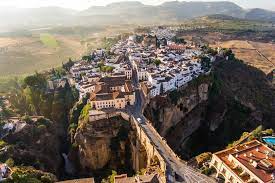 We flew to Malaga, hired a car, had breakfast in old Marbella, then wound our way up to Ronda where we had booked two nights at the Parador hotel. It was August, very hot, but the cool modern parador with its gardens and pool were very welcome. Our room overlooked the Tajo and the valley below and the mountains of the Sierra de Grazalema formed a stunning backdrop. We flew to Malaga, hired a car, had breakfast in old Marbella, then wound our way up to Ronda where we had booked two nights at the Parador hotel. It was August, very hot, but the cool modern parador with its gardens and pool were very welcome. Our room overlooked the Tajo and the valley below and the mountains of the Sierra de Grazalema formed a stunning backdrop.
We enjoyed our two days in Ronda then continued on our way via the pueblos blancos Benaojan, Montejaque, to Arcos de la Frontera and Jerez de la Frontera and then Cadiz. We stayed a night each in the Parador hotels in Arcos – fantastic – and Cadiz – disappointing. Then north via Sevilla and Carmona to Granada and Cordoba, where again we lodged in the Parador hotel.
On our penultimate day it was south to Roman Antequera, where we managed to swim in the Parador pool, even though we weren’t guests.
Back to Malaga for a night in the stunning Gibralfaro Parador above the city before flying home to Liverpool John Lennon airport.
All the places we went to on that tour we have since revisited and they are all lovely. But the two which are special to me are Ronda and Montejaque.
My first wife and I bought an apartment in Ronda the year after our Grand Tour, which we enjoyed as a family for many years. It remained with me long after our divorce in 2005, until I sold it in 2019.
 As a single man, and early retired, I fancied moving to Ronda to live, but that didn’t work out until in 2008 I met the “Lovely Rita, Meter Maid”, a German living in Montejaque. It was not long before I emigrated to live with her in her house there, we got married in 2010 and moved to a big villa just outside Ronda in 2011. The rest is history. As a single man, and early retired, I fancied moving to Ronda to live, but that didn’t work out until in 2008 I met the “Lovely Rita, Meter Maid”, a German living in Montejaque. It was not long before I emigrated to live with her in her house there, we got married in 2010 and moved to a big villa just outside Ronda in 2011. The rest is history.
Ronda and Montejaque are evidently two very special places for me.
Photos courtesy of Trendencias and Ayuntamiento de Montejaque
Oviedo
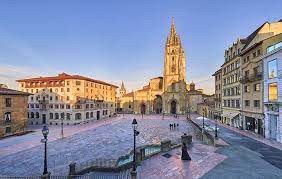 Stepping back to 2005, when I was still working as a schools adviser and inspector, by now for Sefton Council in Merseyside, I went on a study visit to Asturias, again funded by the European Union. Stepping back to 2005, when I was still working as a schools adviser and inspector, by now for Sefton Council in Merseyside, I went on a study visit to Asturias, again funded by the European Union.
We were a group of European educationalists looking at foreign language teaching in primary schools in Asturias.
We were based in Oviedo but we also visited Gijon and other towns and villages to sample primary English lessons.
The professional side of the study visit was very thought-provoking and interesting and well worthwhile. The social side was also fun: I enjoyed the Asturian cider (sidra), the local food and the company of a very vivacious Dutch headteacher.
That’s why Oviedo is on my list.
Photo courtesy of Turismo Asturias
Frigiliana
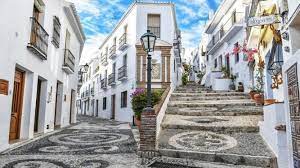 In 2021, while my wife was away in Germany recovering from a very nasty bout of Covid-19, I took myself off for a few days to Frigiliana, arguably the most beautiful of all the white villages in Malaga province. In 2021, while my wife was away in Germany recovering from a very nasty bout of Covid-19, I took myself off for a few days to Frigiliana, arguably the most beautiful of all the white villages in Malaga province.
I was accompanied by Berti, my dog, since then deceased, sadly. Hit and run.
Despite a third of the population of Frigiliana being foreign, it didn’t seem over-run or oppressive, unlike the nearby coastal resort of Nerja.
Berti and I had a great time together and we vowed to return.
When my wife came back to me, recovered, from her homeland, I took her away to Frigiliana for a week to celebrate my 71st birthday. We had a great week, toured around and ate well.
We went for a third time with friends last year, just for lunch, and it was once again a lovely experience.
Definitely worth its place on my list.
Photo courtesy of Malaga Hoy
Extremadura
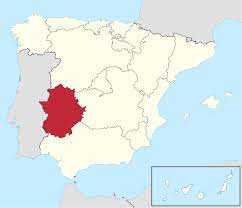 19 years since my last visit to the region, it was time for me to revisit Extremadura. This time I wanted to check out all seven of the paradores located in the region. And I wanted to show my wife Rita this beautiful part of Spain, which is located slightly off the beaten track. 19 years since my last visit to the region, it was time for me to revisit Extremadura. This time I wanted to check out all seven of the paradores located in the region. And I wanted to show my wife Rita this beautiful part of Spain, which is located slightly off the beaten track.
I bought a Five-Night Card, for just 600€. That works out at 120€ per night, breakfast included, and 20% discount on all food purchased in the parador.
I am also an Amigo de Paradores which means there are certain perks like discounted parking, a welcome drink on arrival, and occasional special offers such as tours or other activities.
In addition, for every 3 euros spent you get a point. And what do points mean? Prizes! Well, in the case of this loyalty scheme, you can exchange points for accommodation or meals. In the old days I had many a free night’s accommodation for my accumulated Amigo points.
We visited all seven paradores and stayed overnight in four: Zafra, Jarandilla de la Vera, Trujillo and Merida.
For the overall beauty of the region and their exquisite paradores, plus a previous very enjoyable visit with my first wife and son, I have to regard Extremadura as a very special place.
Map courtesy of Wikipedia
To read more about both visits click here:
Journey to the hard extreme – Extremadura – Part 1 (eyeonspain.com)
Journey to the hard extreme – Extremadura – Part 2 (eyeonspain.com)
Madrid and Toledo
 The Spanish say about their national capital: “De Madrid al Cielo”. In English we say: “See Naples and die!” The sentiment being that Madrid/Naples are such beautiful cities that you can go ahead and die, as nowhere else compares. The Spanish say about their national capital: “De Madrid al Cielo”. In English we say: “See Naples and die!” The sentiment being that Madrid/Naples are such beautiful cities that you can go ahead and die, as nowhere else compares.
Well, I wouldn’t go that far, although Madrid is indeed stunning and spectacular in so many ways.
I’d been on two previous occasions, the first time accompanying my then wife on a business trip, the second to attend an international conference on school inspections. But we had little time to explore the city.
On this occasion I took my now wife Rita to buy a second-hand car! We turned it into a short break and loved it. Rita, who has travelled widely in her life, declared it the most beautiful city she has ever visited. I can’t agree with that, although Rita has never been to Budapest, Paris, Prague nor Vienna.
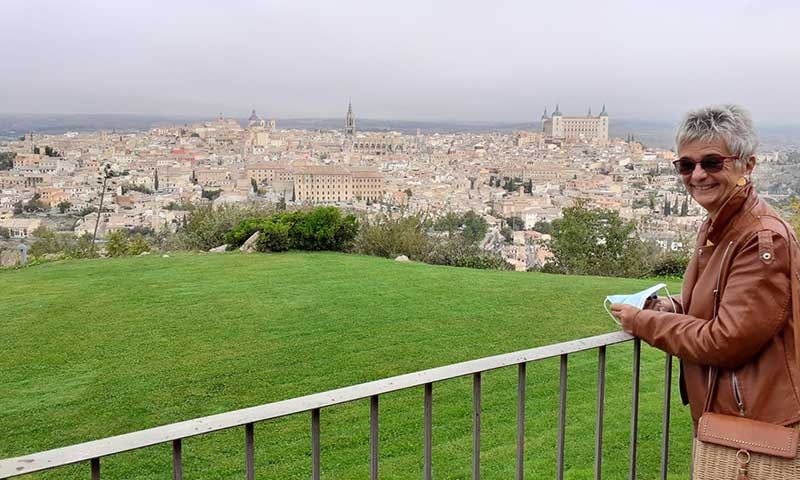 By the way, we bought the car, and travelled back to Andalucia by road. We stopped for a night in Toledo which was enough time to explore this wonderful city, erstwhile capital of Spain. This was also new for Rita. She loved that too, except for the night we got lost. The least said about that the better. By the way, we bought the car, and travelled back to Andalucia by road. We stopped for a night in Toledo which was enough time to explore this wonderful city, erstwhile capital of Spain. This was also new for Rita. She loved that too, except for the night we got lost. The least said about that the better.
So, Madrid and Toledo are special places for me, since I got to enjoy them with my lovely Meter Maid.
Photos courtesy of Wikipedia and Paul Whitelock
To read more about our car-buying trip, click here:
How to buy a car in Spain - Secret Serrania de Ronda
Tags: Barcelona, Basque Country, degree, El Prat de Llobregat, Extremadura, Frigiliana, Fuenterrabia, German, Hondarribia, Jaca, rJarandilla de la Vera, Madrid, Merida, Montejaque, Nerja, Pablo de Ronda, parador, Rita, Ronda, Salford, San Sebastian, Spanish, Toledo, Trujillo, year abroad, Zafra
 1
Like
Published at 8:21 AM Comments (4)
1
Like
Published at 8:21 AM Comments (4)
April Fool!
Saturday, April 1, 2023
 From Orson Welles’ infamous War of the Worlds radio broadcast to Richard Dimbleby's Panorama TV programme about spaghetti trees, we British have always been suckers for a good April Fool joke! In this article, Pablo de Ronda lists a selection of famous pranks that have hoodwinked the people over the years. From Orson Welles’ infamous War of the Worlds radio broadcast to Richard Dimbleby's Panorama TV programme about spaghetti trees, we British have always been suckers for a good April Fool joke! In this article, Pablo de Ronda lists a selection of famous pranks that have hoodwinked the people over the years.
April Foo ls' Day or All Fools' Day is a holiday celebrated in a number of countries on April 1st, although not in Spain, where the equivalent is el Día de los Inocentes, celebrated on December 28th, the date which somewhat bizarrely commemorates the slaughter of new-born male babies by King Herod following the birth of Christ. ls' Day or All Fools' Day is a holiday celebrated in a number of countries on April 1st, although not in Spain, where the equivalent is el Día de los Inocentes, celebrated on December 28th, the date which somewhat bizarrely commemorates the slaughter of new-born male babies by King Herod following the birth of Christ.
April 1st is marked by the perpetration of hoaxes and other practical jokes of varying sophistication on friends, family members, enemies, and neighbours, or sending them on a fool's errand, the aim of which is to embarrass the gullible.
The earliest recorded association between April 1st and foolishness can be found in Chaucer's Canterbury Tales (1392).
Other well-known pranks include:
• Alabama Changes the Value of Pi: The April 1998 newsletter of New Mexicans for Science and Reason contained an article written by physicist Mark Boslough claiming that the Alabama Legislature had voted to change the value of the mathematical constant pi.
 • Left-Handed Whoppers: In 1998, Burger King ran an ad in USA Today, saying that people could get a Whopper for left-handed people whose condiments were designed to drip out of the right side. Not only did customers order the new burgers, but some specifically requested the "old", right-handed burger. • Left-Handed Whoppers: In 1998, Burger King ran an ad in USA Today, saying that people could get a Whopper for left-handed people whose condiments were designed to drip out of the right side. Not only did customers order the new burgers, but some specifically requested the "old", right-handed burger.
• Smell-o-vision: In 1965, the BBC purported to conduct a trial of a new technology allowing the transmission of odour over the airwaves to all viewers. Many viewers reportedly contacted the BBC to report the trial's success. In 2007, the BBC website repeated an online version of the hoax.
• Tower of Pisa: The Dutch television news reported in the 1950s that the Tower of Pisa had fallen over. Many shocked people contacted the station.
• BBC Radio 4 (2005): The Today programme announced in the news that the long-running serial The Archers had changed its theme tune to an upbeat disco style.
• Death of a mayor: In 1998, local WAAF shock jocks Opie and Anthony reported that Boston mayor Thomas Menino had been killed in a car accident. Menino happened to be on a flight at the time, lending credence to the prank as he could not be reached. The rumour spread quickly across the city, eventually causing news stations to issue alerts denying the hoax. The pair were fired shortly afterwards.
• Phone call: In 1998, UK presenter Nic Tuff of West Midlands radio station Kix 96 pretended to be the British Prime Minister Tony Blair when he called the then South African President Nelson Mandela for a chat. It was only at the end of the call when Nic asked Nelson what he was doing for April Fools' Day that the line went dead.
• Jovian-Plutonian gravitational effect: In 1976, British astronomer Sir Patrick Moore told listeners of BBC Radio 2 that unique alignment of two planets would result in an upward gravitational pull making people lighter at precisely 9:47 am that day. He invited his audience to jump in the air and experience "a strange floating sensation." Dozens of listeners phoned in to say the experiment had worked.
 • U2 Live on Rooftop in Cork: In 2009 hundreds of U2 fans were duped in an elaborate prank when they rushed to a shopping centre in Blackpool in Cork believing that the band were playing a surprise rooftop concert. The prank was organised by Cork radio station RedFM. The band were in fact just a tribute band called U2opia. • U2 Live on Rooftop in Cork: In 2009 hundreds of U2 fans were duped in an elaborate prank when they rushed to a shopping centre in Blackpool in Cork believing that the band were playing a surprise rooftop concert. The prank was organised by Cork radio station RedFM. The band were in fact just a tribute band called U2opia.
• Cellphone Ban : In New Zealand the radio station the Edge's Morning Madhouse enlisted the help of the Prime Minister on April 1st to inform the entire country that cellphones were to be banned in New Zealand. Hundreds of callers rang in disgruntled at the new law.
• In 1962 the Swedish national television did a 5-minute special on how one could get colour TV by placing a nylon stocking in front of the TV. A rather in-depth description on the physics behind the phenomena was included.
• In 2004, British breakfast show GMTV presented a story claiming that Yorkshire Water were trialling a new 'diet tap water' that had already helped one customer lose a stone and a half in four months. After heralding the trial as successful, it was claimed that a third tap would be added to kitchen sinks, allowing customers easy access to the water. Following the story, Yorkshire Water received 10,000 enquiries from viewers.
• In 2006, the BBC reported that the door to No. 10 Downing Street, the official residence of the Prime Minister of the UK, had been painted red. They showed footage of workmen carrying a red door. Red was the official colour of the political party which formed the government at the time. The same story was also reported in the British newspaper, The Daily Mail which credited the new design to someone called “April Fewell”. The door is in fact black.
• In 2008, the BBC reported on a newly-discovered colony of flying penguins. An elaborate video segment was even produced, featuring Terry Jones (of Monty Python fame) walking with the penguins in Antarctica, and following their flight to the Amazon rainforest.
• Coldplay to back the Tories - On April 1st, 2006 the Guardian journalist "Olaf Priol" claimed that Chris Martin of rock band Coldplay had decided to publicly support the Conservative Party leader David Cameron due to his disillusionment with previous Labour Party prime minister Tony Blair, even going so far as to produce a fake song, "Talk to David", that could be downloaded via the Guardian website. Despite being an obvious hoax, the Labour Party's Media Monitoring Unit were concerned enough to circulate the story throughout "most of the government".
• Google announces a joint project with the Virgin Group to establish a permanent human settlement on Mars - http://www.google.com/virgle/index.html. This operation has been named Project Virgle. The announcement includes videos of Richard Branson (founder of Virgin Group) as well as Larry Page and Sergey Brin (the founders of Google) on YouTube, talking about Virgle.
• Assassination of Bill Gates: In 2003, many Chinese and South Korean websites claimed that CNN reported Bill Gates, the founder of Microsoft, was assassinated, resulting in a 1.5% drop in the South Korean stock market.
• www.howstuffworks.com does an annual bogus article. In 2006, it was "How Animated Tattoos Work"; in 2007 "How Phone Cell Implants Work"; in 2008 "How the Air Force One Hybrid Works"; in 2009 "How Rechargeable Gum Works".
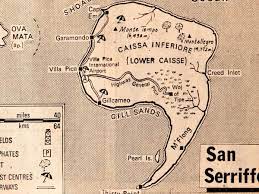 But, my favourite of the lot was San Serriffe. The Guardian printed a supplement in 1977 praising this fictional resort, its two main islands, Upper Caisse and Lower Caisse, its capital, Bodoni, and its leader, General Pica. Intrigued readers were later disappointed to learn that San Serriffe (sans serif) did not exist except as references to typeface terminology. But, my favourite of the lot was San Serriffe. The Guardian printed a supplement in 1977 praising this fictional resort, its two main islands, Upper Caisse and Lower Caisse, its capital, Bodoni, and its leader, General Pica. Intrigued readers were later disappointed to learn that San Serriffe (sans serif) did not exist except as references to typeface terminology.
Have a nice day! But watch out! Pranksters are all over the place!
 2
Like
Published at 4:42 AM Comments (1)
2
Like
Published at 4:42 AM Comments (1)
Spam post or Abuse? Please let us know
|
|